Lithium Niobate Modulator Market Research, 2030
The global lithium niobate modulator market size was $3.7 billion in 2021, and is projected to reach $6.5 billion by 2030, growing at a CAGR of 6.74% from 2022 to 2030.A lithium niobate modulator is an electrical optic gadget that modulates an electro-optic beam using a signal managed element that exhibits an electro-optic effect. The basic idea behind these modulators is to change a material's electro-optical properties such as amplitude, phase, position, and frequency.
Lithium modulators are being developed for applications such as optical computing, digital & analogue signal processing, and communications. Moreover, lithium niobate modulator is an electrical device that modifies an optical light source using a sound wave element with just an electrical effect. Modulators created of lithium niobate are being used to change the battery powered properties of a material including its magnitude, phase, place, and frequency. They find widespread application in optical computing, digital & analogue signal processing, and communications.
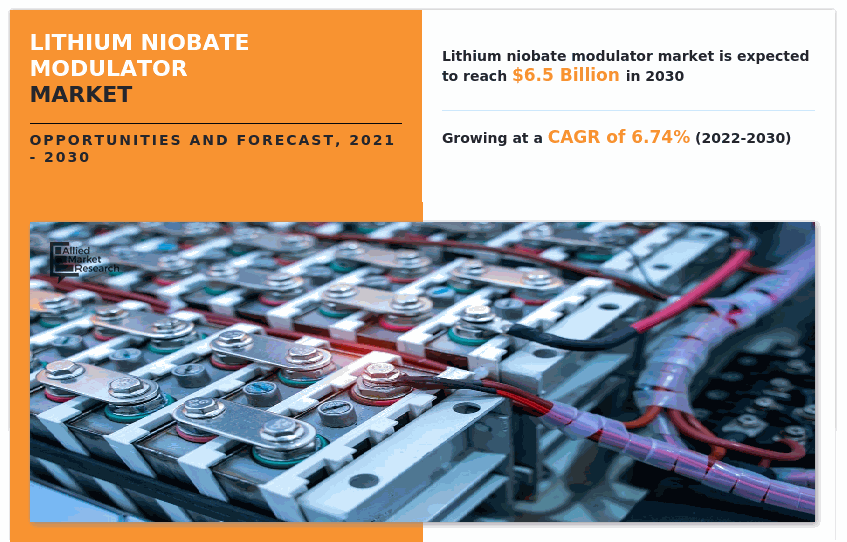
In the defense and aerospace industries, lithium niobate modulators are used in wireless networking devices, spacecraft connectivity, and advanced radar systems. These modulation schemes are being used to track unnamed airplane as well as vessels using the radar detection system. Lithium niobate modulators have a widespread used in telecoms and digital communications systems, and their integration in the IT as well as telecom sectors has been growing. Moreover, advanced technologies and the deployment of 5G data network in the telecommunications field are expected to offer lucrative possibilities again for the lithium niobate modulator industry.
The cost of the modulator is a major restraint on the global lithium niobate modulator market. The price of the lithium niobate modulator is very high compared to other modulators; as a result, most consumers are unable to use these products in their communication.
Segment Overview
The lithium niobate modulator market is segmented into Application, End Use, Type and Wavelength Window.
The global lithium niobate modulator market is segmented on the basis of type, wavelength window, application, end-use, and region. Based on type, the market has been divided into 10 GHz, 20 GHz, 40 GHz, and others. Based on wavelength window, the market has been divided into 800 nm, 1060 nm, 1300 nm, 1550 nm and others. Based on application, the market is divided into phase keyed optical communications, spectrum broadening, interferometric sensing, quantum key distribution and others. Based on end-use, the market has been divided into IT and Telecom, aerospace & defence, industrial, research and others. By region, the market is analyzed across North America, Europe, Asia-Pacific, and LAMEA.
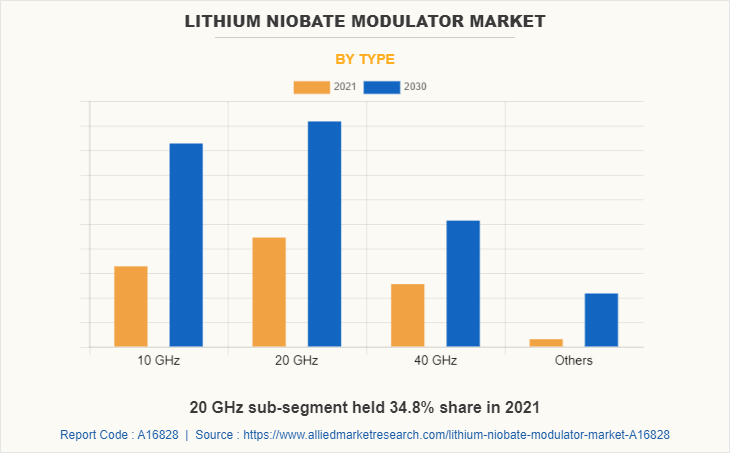
By type, the 20 GHz sub-segment is predicted to have the maximum market share in the forecast period. The 20 GHz modulator is widely used in television broadcasting, microwave devices, and satellite radio services. In order to transfer data wirelessly, a 20 GHz modulator overlays a low-frequency (data) signal onto an elevated (carrier) signal.
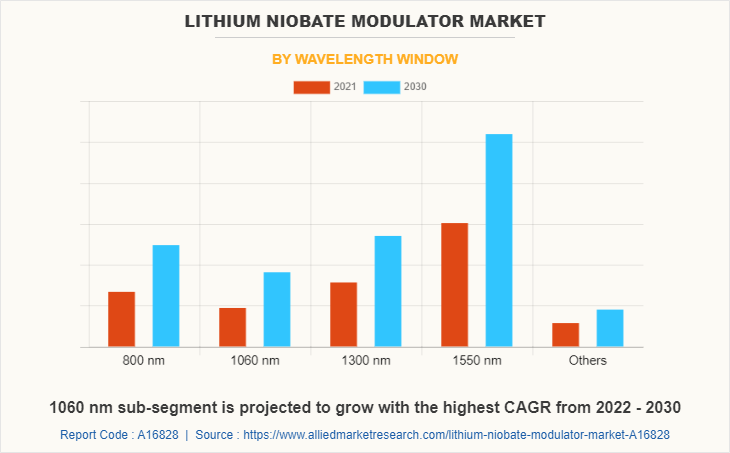
By wavelength window, 1550 nm sub-segment is predicted to have highest market share in terms of revenue. This is due to the increased use of 1550 nm modulators in digital communication, as well as Rayleigh scattering and infrared absorption in the 1550 nm wavelength band. The 1550 nm modulator does have a low insertion loss, a large bandwidth, a low half-wave voltage, and excellent optical power damage characteristics.
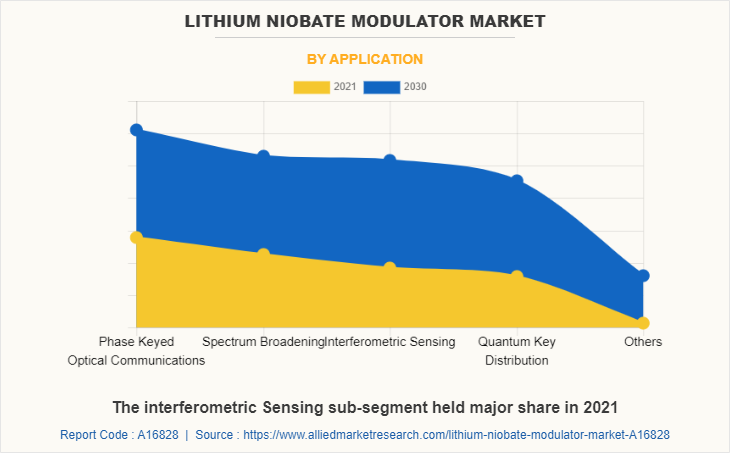
By application, phase keyed optical communications sub-segment is predicted to hold the highest share in terms of revenue in the estimated period. This is due to the widespread use of lithium niobate modulators in phase keyed optical communication devices for aeroplanes to ground. Phase keyed optical communication is a digitally modulated method of transmitting data by modifying (modulating) the same phase of a fixed frequency reference signal (the carrier wave).
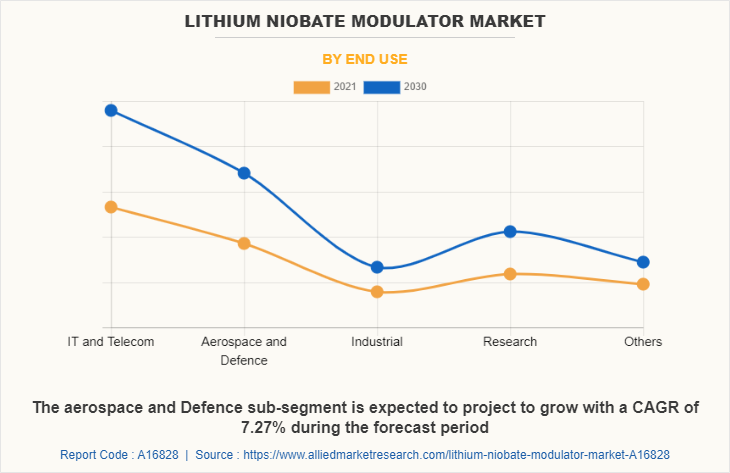
By end-use, IT & Telecom sub-segment is predicted to hold the highest share in terms of revenue in the estimated period. This is due to the increasing use of optical fibre modulators based on lithium niobate in wireless LAN and mobile network services.
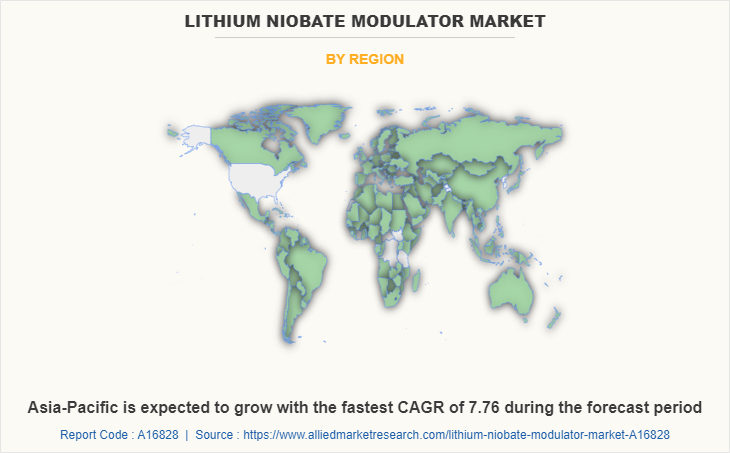
By region, Asia-Pacific lithium niobate modulator market is forecasted to be the fastest growing during the forecast period. China, India, and Japan are rapidly growing economies that contribute significantly to the Asia-Pacific regional market. Furthermore, increased R&D activities, the introduction of new technologies, and cost-cutting methods for lithium niobate modulators are expected to drive the Asia-Pacific lithium niobate modulator market growth.
Competitive Analysis
The key players profiled in this report include iXblue Group, Gooch & House plc, Fujitsu Optical Components Ltd, THORLABS, Beijing Panwoo Integrated Optoelectronic Inc., Fabrinet Inc., Lumentum Operations LLC, and EOSPACE, Inc.
KEY BENEFITS FOR STAKEHOLDERS
- The report provides an in-depth analysis of the global lithium niobate modulator market trends along with the current and future market forecast.
- This report highlights the lithium niobate modulator market opportunity, key drivers, and restraints of the market along with the impact analyses during the forecast period.
- Porter’s five forces analysis helps analyze the potential of the buyers & suppliers and the competitive scenario of the global lithium niobate modulator market for strategy building.
- A comprehensive global lithium niobate modulator market analysis covers factors that drive and restrain the market growth.
- The qualitative data in this report aims on market dynamics, trends, and developments.
- The report provides a lithium niobate modulator market outlook for 2021 and the lithium niobate modulator market forecast from 2022 - to 2030. In addition, the report highlights the lithium niobate modulator market share for each country.
Lithium Niobate Modulator Market Report Highlights
| Aspects | Details |
| By Application |
|
| By End Use |
|
| By Type |
|
| By Wavelength Window |
|
| By Region |
|
| Key Market Players | Fujitsu Optical Components Ltd, Lumentum Operations LLC, Fabrinet Inc., thorlabs, EOSPACE, Inc., Beijing Panwoo Integrated ptoelectronic Inc., Gooch & Housego plc, iXblue Group |
Analyst Review
According to the CXOs of the leading companies, the global lithium niobate modulator market possesses a substantial scope for growth in the future. The market for lithium niobate is heavily influenced by telecommunication applications; it contributes significantly to the value of optical networks through component interconnection. Lithium niobate is used to integrate diverse routing via spatial switches because network security is so important in modern communications. As a result, the lithium niobate modulator is being considered primarily due to its high modulation rate and robustness. The use of an electro-optical modulated signal based on lithium niobate to enable deep interconnection in sectors distributed deep beneath. As a result, electro-optical modulation has been identified as an important component of the communication network. Because they provide electrical isolation, data security, and electromagnetic interference, the optical fibres are ideal for use in the army, industrial, cable television, and utility sectors, which is expected to be the primary driving factor for the worldwide lithium niobate modulator market during the forecast period. According to the CXOs, Asia-Pacific is projected to register faster growth as compared to North American and European markets
To provide continuous internet service, lithium niobate modulators are used in interconnection breakthroughs such as 5G internet and mobile networking. As a result, advanced technologies and the implementation of 5G data network in the field of telecommunication are expected to provide significant possibilities for the lithium niobate modulator market, are projected to accelerate the growth of the lithium niobate modulator market
Agreement, business expansion, and product launch are the key growth strategies of global lithium niobate modulator market players.
Asia-Pacific will provide more business opportunities for global lithium niobate modulator market in the future.
iXblue Group, Gooch & House plc, Fujitsu Optical Components Ltd, THORLABS, Beijing Panwoo Integrated Optoelectronic Inc., Fabrinet Inc., Lumentum Operations LLC, and EOSPACE, Inc. are the leading market players active in the lithium niobate modulator market.
IT and Telecom segment held the maximum share of the global lithium niobate modulator market in 2021.
IT and Telecom, Aerospace and Defence, Industrial and Research Industries include the major customers of global lithium niobate modulator market
The report provides an extensive qualitative and quantitative analysis of the current trends and future estimations of the global lithium niobate modulator market from 2021 to 2030 to determine the prevailing opportunities.
Lithium niobate modulators are well suited for developments in the communication sector such as 5G technology, digital communication to provide continuous internet services, thereby driving the market growth.
The lithium niobate modulator technology is the most reliable and mature in aerospace and defence, and these modulators are used for fibre optic communication and longer distance transmissions. These factors are expected to drive the lithium niobate modulators market in the aerospace and defence sectors, all such factors will ultimately accelerate the global lithium niobate modulator market growth in the next few years.
Loading Table Of Content...



